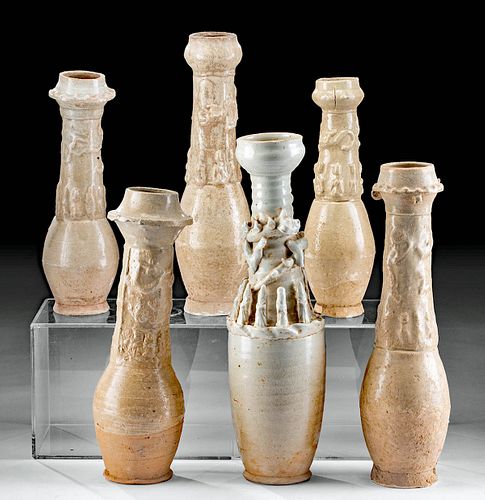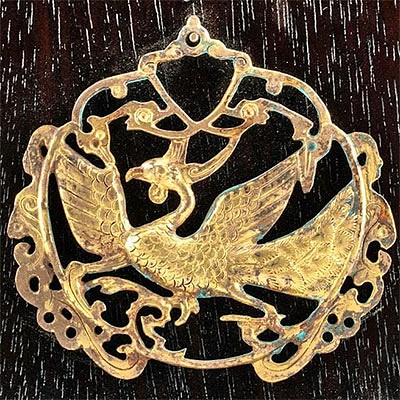Chinese Song Pottery Qingbai Vessels, TL'd, Art Loss
Lot 104
About Seller
Artemis Fine Arts
686 S Taylor Ave, Ste 106
Louisville, CO 80027
United States
Selling antiquities, ancient and ethnographic art online since 1993, Artemis Gallery specializes in Classical Antiquities (Egyptian, Greek, Roman, Near Eastern), Asian, Pre-Columbian, African / Tribal / Oceanographic art. Our extensive inventory includes pottery, stone, metal, wood, glass and textil...Read more
Categories
Estimate:
$4,000 - $6,000
Absentee vs Live bid
Two ways to bid:
- Leave a max absentee bid and the platform will bid on your behalf up to your maximum bid during the live auction.
- Bid live during the auction and your bids will be submitted real-time to the auctioneer.
Bid Increments
| Price | Bid Increment |
|---|---|
| $0 | $25 |
| $300 | $50 |
| $1,000 | $100 |
| $2,000 | $250 |
| $5,000 | $500 |
| $10,000 | $1,000 |
| $20,000 | $2,500 |
| $50,000 | $5,000 |
| $100,000 | $10,000 |
| $200,000 | $20,000 |
About Auction
By Artemis Fine Arts
Jun 17, 2021
Set Reminder
2021-06-17 10:00:00
2021-06-17 10:00:00
America/New_York
Bidsquare
Bidsquare : Ancient & Ethnographic Art Through The Ages
https://www.bidsquare.com/auctions/artemis-gallery/ancient-ethnographic-art-through-the-ages-7094
Ancient art from Egypt, Greece, Italy and the Near East, as well as Asian, Fossils, Pre-Columbian, Native American, African / Tribal / Oceanic, Fine art, and much more! All categories, all price ranges... all legally acquired and guaranteed to be as described or your money back. Artemis Fine Arts info@artemisgallery.com
Ancient art from Egypt, Greece, Italy and the Near East, as well as Asian, Fossils, Pre-Columbian, Native American, African / Tribal / Oceanic, Fine art, and much more! All categories, all price ranges... all legally acquired and guaranteed to be as described or your money back. Artemis Fine Arts info@artemisgallery.com
- Lot Description
East Asia, China, Song Dynasty, ca. 960 to 1279 CE. A lovely collection of 6 stoneware vessels known as Qingbai. Each is formed with a ring foot, an egg-shaped or piriform body, and a tall neck. The necks support a wide, bowl-like mouth with a slightly rolled rim, and some feature a scalloped ridge encircling this area or a carinated edge. One has four petite suspension loops beneath the rim. In addition to the elegant shapes, the vessels are decorated with relief figures that are mold formed or applied. The motifs are similar; robed, abstract humans encircling the body with a soaring dragon above. Qingbai ware (translated as "greenish white") is indicative of the faint, sage-green glaze that covers the pale orange pottery beneath. The distinctive color of the glaze is a result of using pine wood as fuel in the kilns, creating a reduction atmosphere. These vessels were used in southern China during this period to hold grain and other offerings for the deceased. Size of largest: 4.25" W x 15.5" H (10.8 cm x 39.4 cm); smallest: 3.25" W x 11" H (8.3 cm x 27.9 cm)
Two of these vessels have been tested using thermoluminescence (TL) analysis and has been found to be ancient and of the period stated. A full report will accompany purchase.
This piece has been searched against the Art Loss Register database and has been cleared. The Art Loss Register maintains the world’s largest database of stolen art, collectibles, and antiques.
Provenance: private Los Angeles, California, USA collection, 1980s to 2000s
All items legal to buy/sell under U.S. Statute covering cultural patrimony Code 2600, CHAPTER 14, and are guaranteed to be as described or your money back.
A Certificate of Authenticity will accompany all winning bids.
We ship worldwide and handle all shipping in-house for your convenience.
#162246Stable crack to the neck and mouth of one. Losses and chips to the high pointed and applied figures, with softening of mold made details. Chips to bases and rims of all. Chipping and loss of glaze to all. Mineral deposits and earthen encrustations on all, with nice root marks on one. TL hole on the bases of two of these vessels.Condition
- Shipping Info
-
All shipping is handled in-house for your convenience. Your invoice from Artemis Gallery will include shipping calculation instructions. If in doubt, please inquire BEFORE bidding for estimated shipping costs for individual items.
-
- Buyer's Premium



 EUR
EUR CAD
CAD AUD
AUD GBP
GBP MXN
MXN HKD
HKD CNY
CNY MYR
MYR SEK
SEK SGD
SGD CHF
CHF THB
THB













